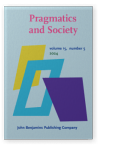Vol. 15:5 (2024) ► pp.661–681
On the constitutional relevance of non‑discursive enlanguaged doings to sociomaterial practices
In expanding on the ‘dynamics first, symbols afterwards’ principle (Cowley 2009) of Distributed Language research, I propose that embodied linguistic competencies comprise the prerequisite for human agents to engage in sociomaterial practices. I make the case that human practical activity is fundamentally ‘enlanguaged’ and that linguistic skills are not only trans-practical in the sense of enabling agents to engage in diverse activities across practices but also that they constitute the basis for adult skill acquisition (see Dreyfus and Dreyfus 1986) more generally. Specifically, I explore language-relative skills as the enablers of more diverse activities than what is prescribed to them by Saussurean linguistic tradition i.e., the denotative relations intrinsic to linguistic signs as well the rule-governed combinations of such signs into meaningful sentences.
Article outline
- 1.Introduction
- 2.Languaging as the starting point
- 3.From language to languaging (or ‘sayings’) and enlanguaged doings: Critically expanding on the accounts of Linell and Schatzki
- 4.The constitutive role of conceptual know-how in practical activity and practices
- 5.Wrapping up
- Notes
-
References
